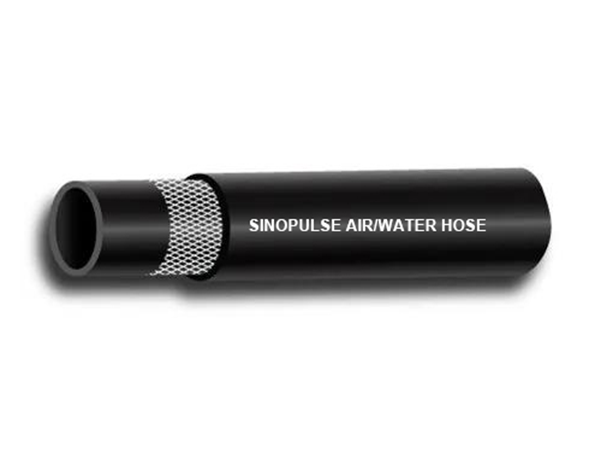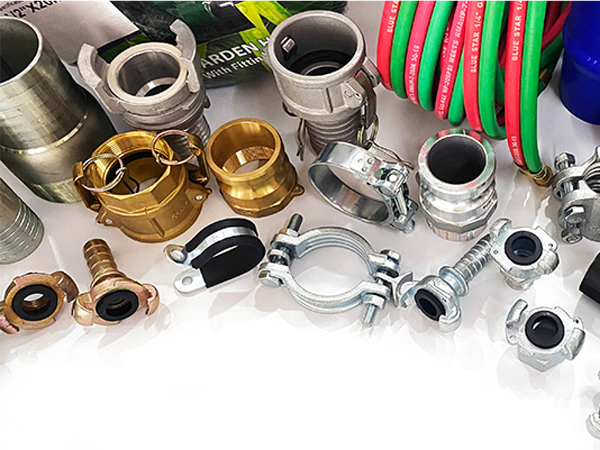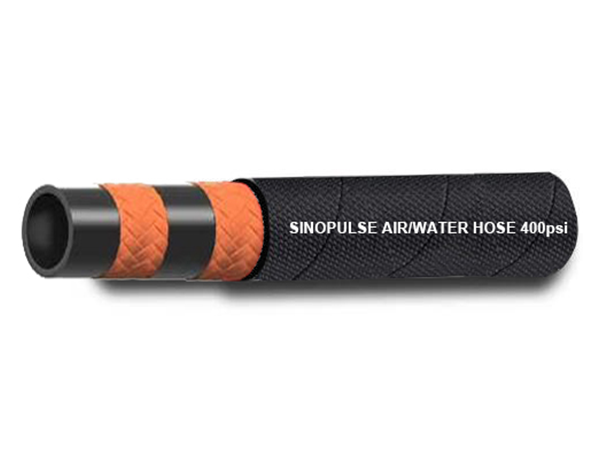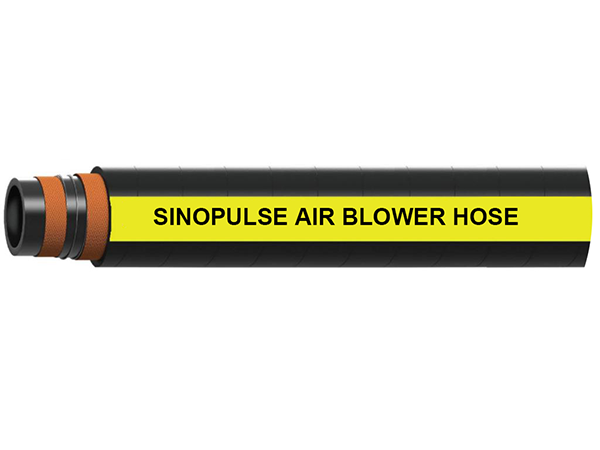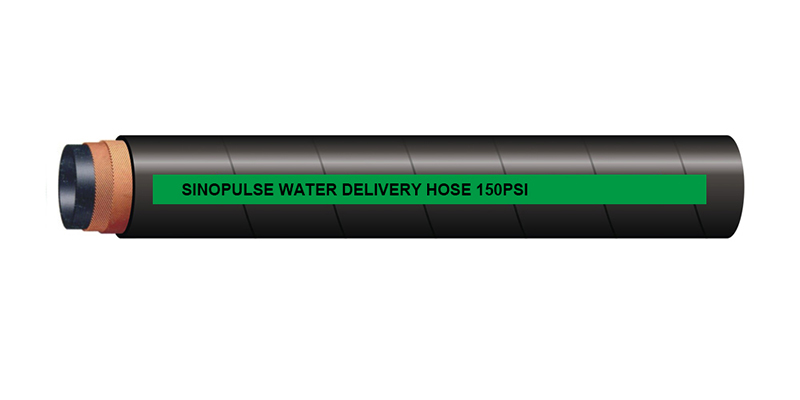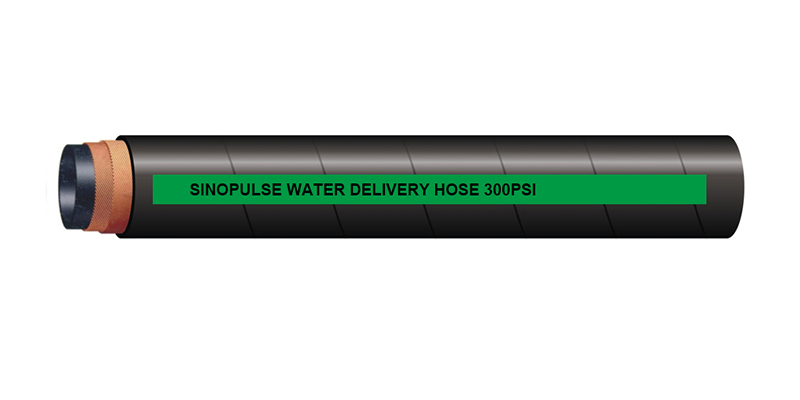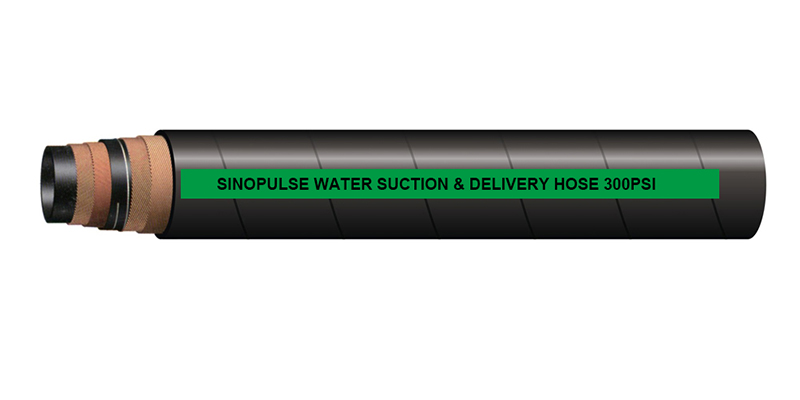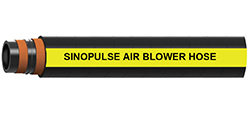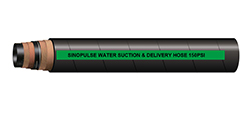Air and water hoses
Air and water hoses are flexible tubes that transfer air or water from one place to another. They are commonly used in industrial, commercial, and residential settings to provide compressed air for power tools, deliver water for irrigation systems, convey water for pressure washing, and various other applications. Air and water hoses are typically made of rubber, PVC, or a combination of materials and are available in multiple sizes and lengths.

Tube: SBR blended, black.
Reinforcement: High tensile synthetic yarn.
Cover: EPDM/SBR blended, black, red, yellow, and blue, weather and ozone resistant.
Temperaturer: -35℃ to + 80℃(22°F to 176°F)
Applications: Widely used for conveying air, inert gas, and water in mining, construction, engineering, shipbuilding, steel production, etc.
Construction
Shipyards
Mining
Agriculture
Quarries
Mild chemical applications
Industrial air placement
Sandblasting equipment
Heavy equipment rental
fittings: PUSH-ON AIR HOSE AND FITTINGS; Strain Relief
Details
1. Air and water hoses with Smooth and corrugated surface
| Inside Diameter | Outside Diameter | Working Pressure | Bursting Pressure | Weight | Length | |||
| Inch | mm | mm | bar | psi | bar | psi | kgs/m | m |
| 3/16" | 4.8 | 12.0 | 20 | 300 | 60 | 900 | \ | 100 |
| 1/4" | 6.4 | 13.0 | 20 | 300 | 60 | 900 | 0.167 | 100 |
| 5/16" | 7.9 | 15.0 | 20 | 300 | 60 | 900 | 0.220 | 100 |
| 3/8" | 9.5 | 17.0 | 20 | 300 | 60 | 900 | 0.270 | 100 |
| 1/2" | 12.7 | 23.0 | 20 | 300 | 60 | 900 | 0.370 | 100 |
| 5/8" | 15.8 | 25.5 | 20 | 300 | 60 | 900 | 0.500 | 100 |
| 3/4" | 19.1 | 30.0 | 20 | 300 | 60 | 900 | 0.650 | 100 |
| 1" | 25.4 | 37.0 | 20 | 300 | 60 | 900 | 0.850 | 50 |
| 1-1/4" | 31.8 | 46.0 | 20 | 300 | 60 | 900 | \ | 50 |
2. Air and water hoses with woven cloth surface
| Inside Diameter | Outside Diameter | Working Pressure | Bursting Pressure | Weight | Length | |||
| Inch | mm | mm | bar | psi | bar | psi | kgs/m | m |
| 1/4" | 6.4 | 13.0 | 20 | 300 | 60 | 900 | 0.31 | 50 |
| 5/16" | 7.9 | 15.0 | 20 | 300 | 60 | 900 | 0.32 | 50 |
| 3/8" | 9.5 | 17.0 | 20 | 300 | 60 | 900 | 0.4 | 50 |
| 1/2" | 12.7 | 23.0 | 20 | 300 | 60 | 900 | 0.55 | 50 |
| 5/8" | 15.8 | 25.5 | 20 | 300 | 60 | 900 | 0.6 | 50 |
| 3/4" | 19.1 | 30.0 | 20 | 300 | 60 | 900 | 0.76 | 50 |
| 1" | 25.4 | 37.0 | 20 | 300 | 60 | 900 | 1.08 | 50 |
| 1-1/4" | 31.8 | 46.0 | 20 | 300 | 60 | 900 | 1.28 | 50 |
| 1-1/2" | 38 | 56.0 | 20 | 300 | 60 | 900 | 1.72 | 50 |
| 2" | 51 | 69.0 | 20 | 300 | 60 | 900 | 2.9 | 50 |
Sinopulse Hose Factory
Raw Material:
Imported rubber material Vietnam and Thailand
High tensile strength 2750Mpa steel wire from China's first-class factory
Powerful, safe and stable hydraulic hose products
Good dispersibility, high bearing pressure and superior pulse performance.
Excellent oil resistance, heat resistance and aging resistance.
Excellent bending resistance and fatigue resistance
Factory Workshop:
Sinopulse is a 100% manufacturer of hydraulic hoses and industrial hoses, including all oilfields, agriculture, transportation, construction, mining, and forestry.
Daily output 500,000 meters of hoses, workshop covering 40,000 m²
40 production lines, involving high-speed joint machines, braiding machines, high-speed spiral machines, Italy VP automatic industrial machines, and Complete series Laboratory Testing Equipment
120 Skilled workers, 6 Engineers with 2 technical counselors from famous international companies,2 QC departments, and 2 warehouse managers are fall of our lovely people.
50 Sales and three groups of logistics specialists serve our clients from Italy, Germany, Uk, Spain, the USA, Canada, Brazil, Argentina, Panama, Peru, Chile, Viet Nam, Indonesia, Australia, Romania

Laboratory:
Our factory introduces a full range of laboratory testing equipment. It has advanced laboratory capabilities to conduct product quality testing and research and development work to ensure stable and excellent product quality.
After purchasing raw materials, we test each batch to ensure they meet our product's technical requirements.
After production, we test each hose, its working and burst pressure, and conduct a pulse test for each order to ensure that it is 100% qualified after leaving the factory.
We strive to provide our customers with top-notch hoses, doing everything we can to ensure their quality.
"Let our end users feel comfortable in use and safe in driving!" is our common goal.

Product packaging:
1. When packing hydraulic hoses, cartons or wooden boxes according to customer requirements.
2. We will pack the hose after finishing the hose production.
3. Generally, woven bags and plastic films are used for packaging.
4. Special packaging can be provided according to customer requirements. Special packaging is a request of Edible ACC Ording customers.

Related Product
Industrial hoses are used for various applications, including conveying water, chemicals, oil, steam, and air in mining, food and beverage, pharmaceuticals, and more.
Fabric rubber hoses are commonly used to convey abrasive materials, sand, gravel, and other bulk materials in the construction, mining, and agriculture industries.
Hose fittings are mainly used to connect and seal pipes, hoses and equipment components in hydraulic systems to ensure the safe transmission of high-pressure fluids.
Our multi-purpose TPR hoses, available with red or black covers, are ideal for handling air, oil, and medium-grade fuels in construction, shipyard, mining, and agriculture applications.
Our heavy-duty, wire-reinforced 600 PSI hoses are available in three different models — one with a standard temperature range, up to 200 °F, one with a high-temperature range, up to 275 °F and one that is wire braided.
Hose is used in industrial, agriculture, and construction applications
We also offer NBR-SBR-blend hoses specifically designed for use in jackhammer applications. Featuring either a red or yellow EPDM cover and two-spiral polyester yarn reinforcement, these 300 PSI hoses provide several unique advantages
Hot Products
Air and Water Hose Guide
What are air and water hoses, and what are their main uses?
Air and water hoses are two common types of flexible hoses used to convey air and water, respectively.
As the name suggests, air hoses are used to deliver air. They are usually made of rubber, plastic, or other flexible material that can withstand some pressure. The main uses of air hoses include:
- Air Tools: Air-powered nail guns, air ratchets, air impact wrenches, etc.
- Inflating equipment: Air hoses inflate tires, balloons, etc.
- Refrigeration system: Air hoses connect refrigeration equipment to deliver refrigerant.
- Ventilation system: Air hoses transport fresh air or discharge exhaust air, such as air conditioners, exhaust fans, etc.
Water hoses convey water or other liquids, usually made of rubber, plastic, or other flexible materials, which are resistant to kinking and can withstand various water pressures and temperatures. The main uses of water hoses include:
- Horticultural irrigation:
- Fire fighting equipment:
- Industrial use: water hoses transport liquid raw materials, coolants, etc., such as chemicals, food processing, and other industries.
- Household use: Water hoses connect household faucets, washing machines, and other equipment to transport water.
In short, air and water hoses are two standard tools for conveying media, which are widely used on various occasions.
What are the common sizes and pressure ratings for air and water hoses?
The common sizes and pressure ratings for air and water hoses vary depending on the application and requirements. Here are some common sizes and pressure ratings:
- Air hoses:
Common inner diameter sizes: 1/4 inch, 3/8 inch, 1/2 inch, 3/4 inch, and 1 inch.
Common pressure ratings: 150 PSI (pounds per square inch), 200 PSI, 300 PSI, and 400 PSI. - Water hoses:
Common inner diameter sizes: 1/2 inch, 5/8 inch, 3/4 inch, and 1 inch.
Common pressure ratings: 50 PSI, 75 PSI, 100 PSI, 150 PSI, and 200 PSI.
When choosing a hose, select the appropriate size and pressure rating based on your specific needs and application.
Are there any industry standards or certifications to look out for when purchasing air and water hoses?
When shopping for air and water hoses, look for the following industry standards or certifications:
- ISO (International Organization for Standardization): such as ISO 9001 (Quality Management System) and ISO 14001 (Environmental Management System).
- SAE (Society of Automotive Engineers): such as SAE J517 (Hydraulic Hose Specification) and SAE J844 (Pneumatic Hose Specification)
- EN (European Standards): such as EN 853 (Specification for hydraulic hoses) and EN 854 (Specification for fuel hoses).
- CE (European Community):
- RoHS (Restriction of Hazardous Substances):
- FDA (US Food and Drug Administration)
- NSF (National Sanitation Foundation)
In conclusion, when purchasing air and water hoses, make sure the products meet applicable industry standards and certifications to ensure safe, reliable, and efficient use.
What safety precautions should be taken when using air and water hoses in the workplace?
- Step 1: Before using the air and water hoses, always check the hoses' integrity to ensure there are no signs of breakage, aging or wear. If there is a problem, replace it immediately.
- Step 2, use the proper hose and fittings, making sure they match the desired application and pressure. Use only compatible parts.
- Step 3, When connecting hoses, make sure the fittings are tight and installed correctly. Use hose clamps or other securing devices to prevent accidental disconnection.
- Step 4, Do not twist, stretch or excessively bend the hose as this could damage the hose or reduce its performance.
- Step 5, During use, periodically check hoses and fittings to ensure there are no leaks or wear. If there is a problem, stop using it immediately and have it repaired or replaced.
- Step 6, Avoid using sharp tools or equipment near the hose that could cut or damage the hose.
- Step 7, When not using the hose, store it in a dry, cool place away from direct sunlight and extreme temperatures.
- Step 8, Do not place heavy objects on the hose that could crush the hose or cause the joint to break.
- Step 9, When using high-pressure air or water, make sure those around you know and stay away from the hose to prevent accidental injury.
- Step 10, When finished using, relieve pressure gradually and disconnect. Avoid keeping the system under pressure to avoid accidental leakage or damage.
- Step 11, Perform regular maintenance and inspections on the hose to ensure it is always in good working order. Follow the manufacturer's recommendations and guidelines to ensure proper use and maintenance of the hose.
What is General Purpose Rubber Air Hose?
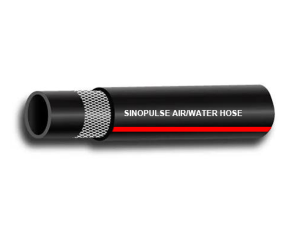
This general-purpose hose is perfect for use on the job site. It is made of natural and synthetic rubber with a high-strength polyester fiber layer. It comes with solid brass end fittings. This hose has high burst strength, is rated for 300 PSI working pressure, and meets RMA's recommended 4:1 safety factor. It is also heat/cold resistant and remains flexible over a temperature range of -40 to 190°F (-40 to 90°C).
We offer red rubber air hose in 1/4, 3/8, and 1/2-inch diameters. This hose is available in 50-foot lengths or custom lengths.
Tube: Natural Rubber & SBR synthetic rubber, black color
Reinforcement: 1 or 2 layers Layers of High Strength Polyester Yarn
Cover: Natural Rubber & Synthetic Rubber Blend, Smooth or Wrapped Surface, Black, Yellow, Red Available
Features: oil mist resistant hose, aging resistant synthetic rubber, weather and ozone resistant, excellent abrasion resistance
Operating temperature: -40°C (-104°F) to 80°C (+176°F)
Heavy duty for contractor use, high burst strength, maintains flexibility -40°F to 190°F
Fittings: Solid Brass end fittings (1/4, 3/8, and 1/2“ 1/4, 3/8, and 1/2” hoses 50' lengths with either 1/4“ or 3/8” Male NPT Brass Fittings)
Bend Restrictor: prevents damage to nearby hoses End Fittings
Pressure: Pressure 300 PSI working pressure, exceeding RMA 4:1 safety factor (burst pressure to WP ratio)



